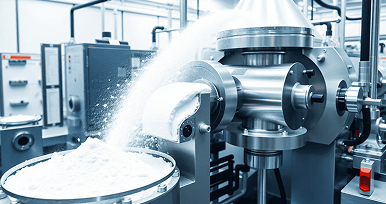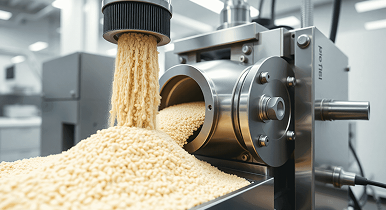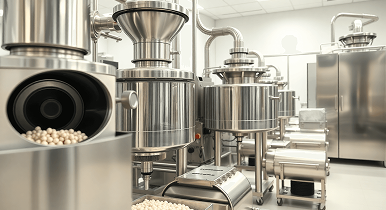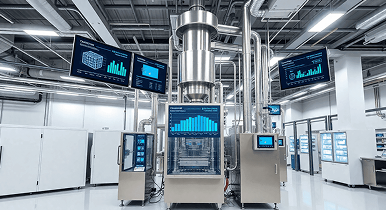I. Introduction to Granulation in Pharma
In pharmaceutical manufacturing, there's one essential but often underappreciated step that quietly dictates the success of many oral dosage forms — granulation. It's not as flashy as drug discovery, nor as headline-grabbing as artificial intelligence in R&D. But without granulation, your tablets may crumble, segregate, or fail quality checks.
At its core, pharmaceutical granulation is the process of converting fine powders — often a mixture of active pharmaceutical ingredients (APIs) and excipients — into larger, multi-particle structures called granules. These granules are easier to compress, flow better, and ensure dose uniformity, which is vital for patient safety and regulatory compliance.
This comprehensive guide is designed to help pharma professionals, formulation scientists, equipment buyers, and quality teams understand everything about granulation — from techniques and equipment to manufacturers and machine selection frameworks.
II. Why Granulation Matters in Solid Dosage Manufacturing
Let's begin with a scenario.
Imagine a production line where a high-potency drug must be compressed into a consistent 250 mg tablet. The active ingredient is just 5 mg — the rest is filler, binder, and lubricant. Without proper granulation, the 5 mg of API might segregate from the blend, leading to dose variability. This isn't just a manufacturing issue — it's a compliance risk and a patient safety hazard.
Key Benefits of Granulation:
Where Is It Used?
Granulation is foundational for the production of:
- Tablets (immediate & sustained release)
- Capsules (especially when compacted blends are needed)
- Sachet formulations
- Pellets (via specialized granulation lines)
Whether you are producing painkillers, antibiotics, or nutraceuticals, granulation is the silent pillar of formulation integrity.
III. Types of Granulation in Pharmaceutical Manufacturing
Granulation isn't a one-size-fits-all process. The method you choose depends heavily on your formulation's sensitivity, processing requirements, and desired tablet characteristics. In this section, we'll explore the two main types of granulation — wet and dry — along with modern alternatives used in specialized scenarios.
A. Wet Granulation
Wet granulation is the most widely used method, where a liquid binder is added to powders to agglomerate them into granules. This method is ideal when the API or excipients are poorly flowable or have low compressibility.
Key Principles:
- Uses moisture or solvent to activate binding.
- Creates strong, dense granules.
- Requires a drying step to remove excess moisture.
When to Use:
- API dose is low and uniformity is critical.
- Powder is poorly compressible or too dusty.
- A specific release profile (e.g., sustained-release) is needed.
B. Dry Granulation
Dry granulation is the method of choice when the formulation is sensitive to heat or moisture. No liquid binders or heat-based drying are used — instead, mechanical force is applied to compact the powder into slugs or ribbons.
Key Techniques:
- Slugging: Compression using tablet press to form large slugs.
- Roller Compaction: Uses two counter-rotating rollers to compact material continuously (modern, preferred method).
When to Use:
- API is unstable in the presence of water or heat.
- Fewer process steps are desired.
- Flowability improvement is needed with minimal processing.

High-Shear Granulator vs Fluid Bed Dryer
Read moreC. Emerging Granulation Technologies
As continuous manufacturing and sustainability take center stage, several advanced granulation techniques are gaining traction:
- Steam Granulation: Uses steam instead of organic solvents for binding, ideal for green chemistry.
- Melt Granulation: Employs a meltable binder (e.g., PEG) — no drying required.
- Foam Granulation: A foam solution of binder is sprayed instead of liquid — lower moisture use.
- Reverse Wet Granulation: Powder is added to binder instead of the other way around — reduces agglomeration.
- Twin-Screw Granulation: Continuous process with integrated blending, granulation, and drying.
IV. Step-by-Step Granulation Process Workflow
Now that we know the types, let's walk through the step-by-step granulation process for both wet and dry methods. This section also integrates keywords like granulation process pharma, fluid bed dryer granulation, and high shear granulator.
A. Wet Granulation Process (Traditional Batch Method)
Binder selection in wet granulation is critical — improper binder viscosity or volume can lead to over-granulation or friable granules.
B. Dry Granulation Process (Using Roller Compaction)
C. Continuous Granulation Line (Modern Systems)
Continuous lines integrate multiple functions — feeding, wetting, granulating, drying, and size reduction — into a single system, offering:
- Real-time process monitoring (PAT)
- Higher throughput
- Lower manpower cost
Leading technologies include:
- Twin-screw granulators (e.g., Thermo Fisher, GEA)
- Modular continuous systems from GEA, IMA, and Fette Compacting

Continuous Granulation Technology & Benefits
Read moreV. What Makes a Good Granule? Quality Attributes & In-Process Testing
No matter how sophisticated the machine or method, the true success of a granulation process lies in the quality of the resulting granules. Granules must meet specific physical, chemical, and mechanical criteria to ensure they compress well into tablets or fill uniformly into capsules.
Here are the critical attributes of high-quality granules:
A. Physical & Flow Properties
B. Content Uniformity
Uniform API distribution in granules is critical to avoid dosage variability.
- Measured using: HPLC/UV assay of multiple granule samples
- Acceptance criteria: RSD < 5%
C. In-Process Controls (IPCs)
Real-time granulation is often monitored via:
- PAT tools for binder content, moisture, and density
- Near-infrared (NIR) and Raman spectroscopy in continuous lines
- Sampling every batch/lot for QC lab analysis
Granule quality also affects final tablet characteristics like disintegration, dissolution, hardness, and uniformity of weight — making this step non-negotiable in process optimization.
VI. Equipment Used in Granulation: A Complete Breakdown
Granulation is not just about mixers — it's a system of interdependent machines, each engineered to carry out a specific task: blending, granulating, drying, sizing, and final mixing.
Below is a comprehensive table of equipment used in pharmaceutical granulation, along with their role and placement in the process.
A. Equipment Matrix
B. Equipment Spotlight
High Shear Granulator
- Consists of an impeller, chopper, and cylindrical bowl.
- Rapidly agitates powders and binder to form a homogeneous wet mass.
- Top manufacturers: GEA (UltimaGral), IMA (ROTO MIX), Gansons (SuperGran), ACG (GT series)
Fluid Bed Dryer
- Suspends granules in hot air stream for uniform drying.
- May include spray nozzles for granulation or coating.
- Top manufacturers: Glatt, ACG, IMA, Diosna
Roller Compactor
- Two counter-rotating rollers compress powder into a ribbon.
- Ribbon is milled into granules with consistent density.
- Ideal for continuous dry granulation.
- Top manufacturers: Alexanderwerk, Freund Vector, Fitzpatrick

Roller Compaction: Dry Granulation Methods
Read moreBin/V-Blender
- Provides uniform blending post-granulation.
- Lubricants are added here to prevent sticking during compression.
- CIP/SIP models available for sterile zones.
C. Modern Systems with Integrated Controls
Advanced systems now come with:
- PAT tools for online monitoring
- CIP (Clean-in-Place)
- SCADA-based automation
- HEPA filtration
- Explosion-proof design (ATEX compliant) for solvent-based granulation
VII. How to Choose the Right Granulation Method and Equipment
Selecting the right granulation approach isn't just about machine availability. It's a strategic decision that directly affects:
- Formulation stability
- Regulatory compliance
- Scale-up feasibility
- Cost-efficiency
Let's break it down.
A. Decision Matrix: Wet vs Dry Granulation
B. Granulation Equipment Selection Framework
Choosing a granulation machine involves more than specs. Here's a framework:
1. Material Compatibility
- Moisture/heat sensitivity?
- API reactivity with binders or steel?
2. Batch Size & Throughput
- Is the machine scalable?
- Can it handle pilot + commercial volumes?
3. Automation & Control
- Does it support SCADA, PAT, NIR analytics?
- Real-time monitoring capabilities?
4. Ease of Cleaning & Validation
- Is it CIP/SIP ready?
- Are all product-contact parts easily dismantled?
5. GMP & Regulatory Readiness
- Is the vendor known for GMP-compliant builds?
- Are documentation and validation packs provided?
6. Support & After-Sales Service
- Local support?
- Spare part availability?
C. Buying Tip: Cost vs Value
- Don't chase lowest price. Consider energy efficiency, maintenance cost, and automation.
- Evaluate total cost of ownership (TCO), not just CAPEX.
- For startups: Consider refurbished or modular skid-mounted systems with upgrade paths.
VIII. Buyer's Guide: Selecting the Right Granulation Equipment
Whether you're scaling a startup or upgrading a commercial plant, the success of your solid dosage line often begins with the right granulation equipment. Here's a practical guide to evaluate, shortlist, and finalize the best-fit machine.
A. Step-by-Step Buying Process
1. Define Your Use Case
- R&D, Pilot, or Production?
- Batch size (e.g. 10L, 100L, 500L)?
- Wet or dry granulation — or both?
2. Map Functional Requirements
- API moisture/heat sensitivity?
- Need for specific release profile?
- Requirement for integrated fluid bed dryer?
3. Shortlist Machines Based on Technical Fit
4. Evaluate Vendors on:
- Support availability (local + remote)
- Customization flexibility
- Validation packages
- Machine footprint (space constraints)
- Upgrade paths (can it be automated later?)

Pharmaceutical Granulation Equipment Buyers Guide
Read moreB. Granulation Equipment Evaluation
Here's a practical evaluation sheet for procurement teams:
C. Bonus Tip: Ask for FAT + SAT Video Recording
For regulatory ease, always request:
- Factory Acceptance Test (FAT) video
- Site Acceptance Test (SAT) walkthrough
- Installation Qualification (IQ) & Operational Qualification (OQ) protocols
This simplifies audit readiness with FDA, CDSCO, and EU regulators.
IX. Regulatory, Validation & GMP Guidelines for Granulation
Granulation — whether wet or dry — directly affects critical quality attributes (CQAs) like content uniformity, tablet weight variation, and dissolution. Regulatory bodies worldwide pay close attention to how you validate and control this stage.
A. Validation in Granulation
A validated granulation process ensures batch-to-batch reproducibility under defined operating parameters.
Key Validation Parameters:
- Binder concentration and volume
- Mixing time and speed (impeller & chopper)
- Granule size distribution
- Moisture content after drying
- Final blend homogeneity
Validation Phases:
- Installation Qualification (IQ) – Verifying machine specs & calibration
- Operational Qualification (OQ) – Confirming functionality under varied conditions
- Performance Qualification (PQ) – Running the process and proving output meets quality specs
B. Regulatory References
C. Process Analytical Technology (PAT) for Granulation
PAT tools allow you to monitor critical process parameters like:
- Moisture level during drying (via NIR)
- Granule size (via particle image analysis)
- API blend uniformity (via Raman)
Bonus: Using PAT reduces the number of destructive in-process QC checks — and helps transition from batch to continuous granulation.
D. Cleaning, Cross-Contamination & GMP
Granulation is often done in dedicated zones or rooms, and needs strict SOPs:
- CIP (Clean-in-Place) or manual cleaning protocols
- Visual inspection + swab testing after every batch
- Equipment logs + cleaning validation reports
- Line clearance before starting a new product
X. Common Challenges in Granulation & How to Troubleshoot Them
Even with the right process and machines, granulation can be a delicate balancing act. Small deviations in parameters like binder volume, drying time, or impeller speed can cascade into batch failures or OOS results.
Here are the most frequent granulation issues and proven troubleshooting approaches:
A. Problem: Over-Granulation
- Symptoms: Granules too large or hard; poor compressibility
- Causes:
- Excess binder volume
- Prolonged mixing after binder addition
- Fix:
- Re-optimize binder concentration and spray rate
- Reduce wet massing time
- Use online moisture sensors to control binder stop-point
B. Problem: Under-Granulation
- Symptoms: Granules too fine, dusty, poor flowability
- Causes:
- Low binder content
- Inadequate wet massing
- Fix:
- Improve binder distribution (increase spray pressure or impeller speed)
- Switch to higher viscosity binder (e.g., PVP K30 instead of K15)
C. Problem: Non-Uniform Granule Size
- Symptoms: High RSD in assay, variable tablet weight
- Causes:
- Improper sieving/milling
- Binder pooling or poor spray pattern
- Fix:
- Use oscillating granulator or cone mill post-drying
- Maintain chopper speed to break up agglomerates evenly
D. Problem: High Residual Moisture
- Symptoms: Tablets stick during compression or fail stability
- Causes:
- Incomplete drying
- Poor airflow in fluid bed dryer
- Fix:
- Optimize drying cycle (inlet temp, hold time)
- Use PAT/NIR for real-time moisture cutoff
E. Problem: API Segregation in Final Blend
- Symptoms: Poor content uniformity in tablets
- Causes:
- API is lighter/finer than excipients
- Lubricants added unevenly
- Fix:
- Blend APIs with excipients before granulation
- Use anti-segregation agents (colloidal silica)
XI. The Future of Granulation: Trends, Tech & What's Next
As pharma manufacturing embraces efficiency, precision, and compliance, granulation is undergoing a quiet revolution. Here are the trends shaping its future.
A. Continuous Granulation is Becoming Mainstream
- Enables real-time quality control with NIR/PAT
- Reduces batch-to-batch variability
- Shortens batch turnaround from hours to minutes
- Compatible with Industry 4.0 platforms
🏭 Leaders: GEA, Thermo Fisher, Freund Vector
B. AI-Powered Process Optimization
Machine learning models now:
- Predict binder volume based on blend characteristics
- Adjust granulation endpoint automatically
- Reduce trial batches in tech transfer
🧠 Tools like digital twins allow simulation before physical scale-up.
C. Advanced Formulations Need Advanced Granulation
- Melt granulation enables solvent-free delivery
- Foam binder systems reduce drying energy by up to 50%
- Co-processing APIs with excipients improves bioavailability

Emerging Trends in Granulation 2025
Read moreD. Sustainability is Driving Equipment Innovation
- Energy-efficient fluid bed dryers
- Steam granulation (no solvents, no VOCs)
- Modular designs for multi-product cleanrooms
E. Globalization & Outsourcing Trends
- CDMOs are investing in flexible granulation lines
- Equipment vendors now offer granulation-as-a-service
- Emerging markets (India, Vietnam, Brazil) drive demand for compact, affordable units
XI. Conclusion: Granulation is Where Quality Begins
Granulation is no longer just a step before compression — it's the heart of dosage form consistency, safety, and compliance. Whether you're choosing a high shear mixer, troubleshooting a sticky batch, or evaluating a continuous line, the decisions you make in granulation resonate through the entire manufacturing cycle.
From binder viscosity to roller compaction pressure, from flow aids to PAT sensors — this process demands precision, expertise, and vision.
If done right, granulation is where the product becomes robust, the formulation becomes elegant, and the process becomes repeatable.
